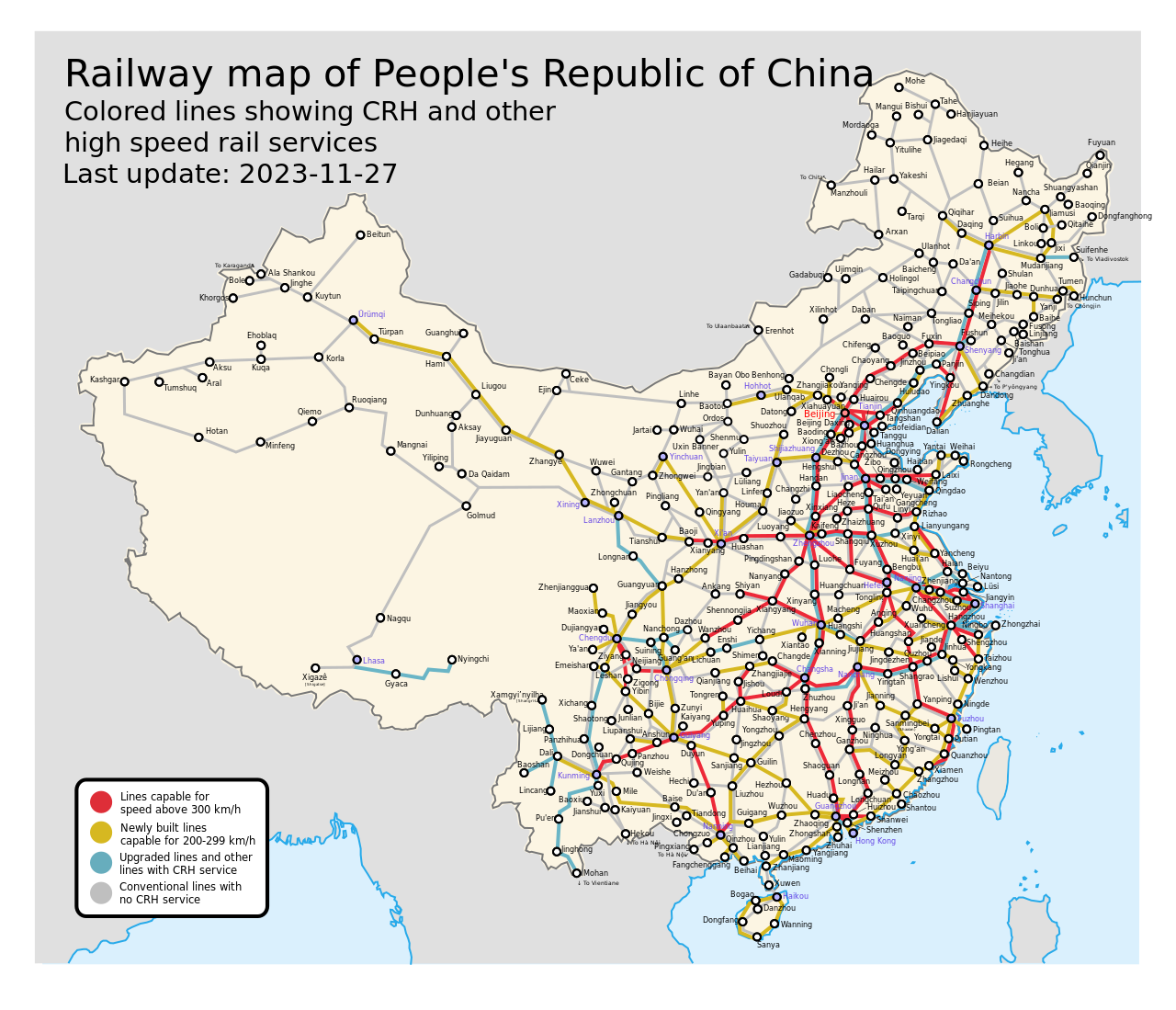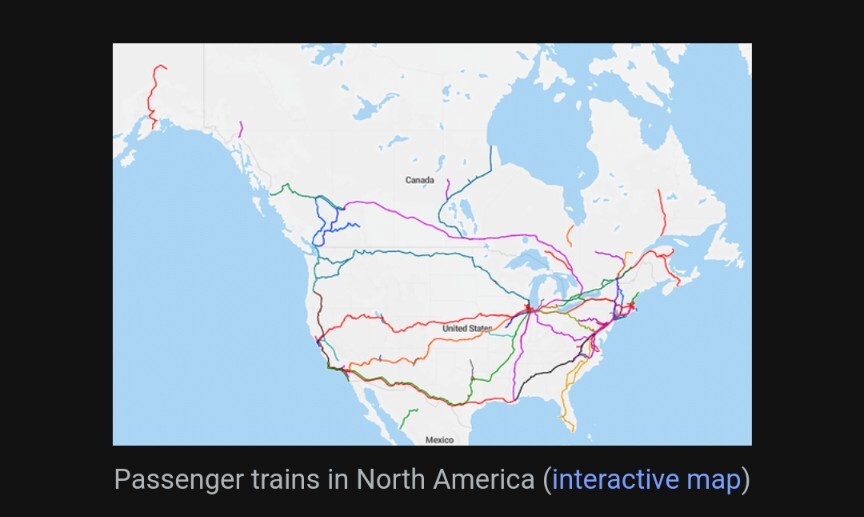Detroit is now home to the country’s first chunk of road that can wirelessly charge an electric vehicle (EV), whether it’s parked or moving.
Why it matters: Wireless charging on an electrified roadway could remove one of the biggest hassles of owning an EV: the need to stop and plug in regularly.
Americans will literally do anything to not build trains
I would love to have both. Especially trains! The trains here are so bad though. They cost more than flying and are such a hassle to deal with. The train stations are sometimes far away from the city in some cases too. So you need a ride from the station.
I would support building that out if it was offered.
The roads are there. They ain’t moving skyscrapers in major cities! For better or worse, American travel is very road-based, and we’ll never have as many diverse options as some other countries…
Or just build trains. Which move tons of people, every day, for cheaper, safer, faster and overall more efficient ways. Don’t have space for a train track? Make it a tram. Problem solved by changing up a road for cars into a road for cars and trains.
Or do what has been done for over a century now and just build the train line underground if there’s no room above. It’s more expensive, but in moderately dense cities that can still be worth it.
There’s public transport in large and dense cities. It doesn’t work to move around the country very well. These people that think something that works in a country that’s smaller than an individual state in the US should work fine are “special”.
… but this is Detroit which is a city that can support NFL, MLB, NBA and NHL teams. We’re not taking about the sticks here
Japan is the size of the entire east coast and has high speed interconnected rail.
There’s only about 800 cities to connect in all of Japan.
There’s about 19,000 in the US.
You prove my point. Japan is small and easy to get everywhere by rail. The US is not.
Yeah, area wise Japan is about 60% the size of Texas. With Japan having more than twice the GDP. Seems pretty straight forward why infrastructure should be better there. Japan has 4x the populous as well. Makes a lot more motivation to focus on public transport.
Trains are amazing for small countries, or between cities. The problem comes when you take into consideration how spread out the US is. You will always have cases where a car is needed, it’s unavoidable.
EVs are not a perfect solution, by a long shot. And ideally we would move away from cars being ubiquitous in America, but that is many, many years off. It’s better to work towards that slowly than it is to say “well it’s not perfect so let’s just not.”
You will always have cases where a car is needed, it’s unavoidable. That’s because it’s designed for cars. We have huge parking lots designed for cars but nothing for public transport. Whenever I travel to NYC or Chicago, I can go anywhere in trains and buses. In my city, I can’t even get milk without driving to a store.
Because your store probably doesn’t serve thousands of people to validate the cost of the infrastructure. My city has busses, but it also has corn fields and open lots and a lot of spread. It’s just not viable to walk all your groceries a mile to and from the bus stop both ways for a bus that comes every hour. It’s different when every train and bus is full and the need is well met.
Ask for more taxes and more spending on this infrastructure, or use your car.
The infrastructure is developed around cars so obviously using cars makes sense. We could have smaller grocery stores and have it closer to neighborhoods so people can walk to it but we have buses which only come once an hour which takes 30 minutes to drive 2 miles and your grocery trip will take 3 hours so you are better off just buying a car!
I don’t think you understand how spread out rural America is. A lot of areas have tiny grocery stores to support a small population spread over a wide area.
The town I grew up in had no grocery stores, there was one small store a 20-min drive away that served all the surrounding towns. There was no work from home and if you had a job you had to have a car to get there.
The population was too small and too spread out to support any public transit. They now have a bus that goes from the center of town to the previously-mentioned grocery store, once a week on Sunday at 7am and then back at noon.
Still, getting to the center of town is quite the hike for many residents so I imagine for most a car is still essential.
And before anyone mentions the “infrastructure” being built for cars: this town was founded before cars were a thing. It was built for horses.
Rural areas can keep their cars. 80% of America’s population is urban, not rural. We do not need to hold back fixing things in cities just because rural America needs cars.
I don’t think you understand how spread out rural America is.
But still that’s not the point.
It has been decided to build infrastructure for cars into the smallest furthest villages and not to build infrastructure for trains into the smallest same villages.
That’s why it is like it is.
Some other countries have made better decisions.
Oh pish posh. China is exactly as big as the US and you can get pretty much everywhere for a few bucks in high speed trains.
Trains are fantastic and the US should definitely be investing in them, it’s a huge disadvantage and a national embarrassment that we don’t have affordable and effective mass transportation.
China does a lot of stupid things, but their train network is admirable.
Truth
“Everywhere” as long as you’re just trying to get to the south-east, sure.
Nope, everywhere.

That ain’t everywhere.
Certainly more than the US though.
That is everywhere that Chinese people live in that country. They consolidated their flyover zones to the left side of the country.
Most of that region is mountains, tundra, and desert. Nobody lives there for a reason.
everywhere
Don’t look at the left side of the map tho
More than 96 percent of the Chinese population lives in the eastern half of that country.
The trains go to the population centers of the 3 and 1/2% on the west side.
Trains service everyone everywhere people are in that country.
There is no concentration of US citizens like this. We are more like the left side of the map than the right. There is no way to service the number of scattered towns we have with one rail line without a truly massive expenditure of resources and I just do not see the point in locking resources into that instead of maintaining current infrastructure for far less
Far better to focus these energies on mass transit within cities themselves without rebuilding from scratch for no reason.
96 percent of Chinese people live on the east half of the country.
Yes, so the trains make sense in certain areas. The US has a similar problem, with the majority of the population in a few specific areas which are already served well by trains. But you then have extremely sparse population spread out through the rest of the country. Trains just don’t work there.
US cities are definitively not already served well by trains. Trains are prohibitively expensive, literally falling apart and very rare, even in larger population centers in the US.
Trains would work very well in this country as they work in literally every country that invests in transportation infrastructure.
You can’t even get high speed rail between LA and San Fransisco (yet). US cities in dense areas are not well served by trains.
isn’t that exactly what trains were designed for and are best at?
You are correct. I can only assume that person got trains and trams mixed up.
You have a train that takes you directly to your house? O.o
Are you implying other countries don’t have train stations? They just stop at each individual houses because it’s a small country?
Also, the biggest city in the US is set up on a giant train system (Im referring to New York’s subways).
No, obviously not. But they also don’t have stations in rural areas where there are houses with many, many miles between them.
That’s nice. It’s a small percentage of the population, and getting smaller. They can keep using cars if they want. We don’t need to hold back all other progress on their account.
Cool, of course that has nothing to do with the original argument….
To be honest, I do see where you are coming from. If we had public transportation as good as our network of roads, people would have incentives to cluster up in the first place.
Shape defines function and function defines form. In this case that means the public transit would be built near the denser populations which will then cause people to move closer to the transport I on for ease of moving goods. It’s why these other countries look the way they do, they didn’t plan these out 3000 years in advance.
Other countries are no percent of the size of the US. The entire Indian subcontinent can fit on our eastern seaboard with room to spare.
The US is big, and has a lot of cities. We have an enormous amount of existing road infrastructure. We are not going to stop using all of that infrastructure any time soon - that’s just reality.
You’re acting like this change would be “just build trains lol” and that couldn’t be more incorrect.
We built those highways over the last 70 years, with most of the work done in the first decade or two of that timespan. These decisions are not immutable laws of nature. They can be undone if we determine they are bad, and they pretty clearly are.
I have not seen a convincing argument that highways are bad. Do you have a link on that?
If we built trains we would start at the most densest areas. Most of these would move people (subways). This builds more railway tracks that could aslo send goods to rural arras as well.
The trains would do 2 things. One would most likely start clustering people together do to the ease of use of having more railways. Second, it creates more economic opprunties for the rural folks (like having a means to work in the city more or just having a way to sell goods) could cause enough economic success for buses.
I’m all about both jacking up density and expanding mass transport any way we can in urban areas. It’s got to creep out from there though. We can’t just wipe the slate clean and start over in a decade.
I’m constantly proselytizing to people locally to vote for and be interested in changing zoning and regulations policies. I’m super annoying about it if I’m drunk lol
… you’ve never heard of bikes, or legs, or car sharing if you need to transport stuff? you don’t need to own a car, it’s unnecessarily expensive and bad for literally everything
the only reason one would need to own a car is if it’s tied to their job
even if you disagree with this assessment, the technology in this post would almost certainly only be applied in cities, it would likely be restricted to a portion of where trains would be except be far less useful, while taking up tax money that could be used for actually important things
also the US has a higher percentage of the population in urban areas than Europe (82% vs 74%) – the US has a lot less small & isolated villages/towns and historically immigrants to the US always came to large urban areas – and US states are comparable in size, population, economy, and arguably self-governing capacity to European countries (the EU can practically be treated as a soveirgn state itself, in most cases), it’s reasonable to say that something that can be implemented in Europe can usually be implemented in the US with a similar level of success, in theory.
you don’t need to own a car, it’s unnecessarily expensive and bad for literally everything
This is a completely unrealistic scenario for the overwhelming majority of Americans
Trains are amazing for small countries, or between cities.
Trains have their bigger advantages on long distances. You get tired in a car, you can’t go pp or take a nap. Your costs rises proportionally with the distance etc.
Trains famously bad at traveling long distances.
No, trains famously bad at “last mile” travel, except that in America it can be “last dozen miles” between a city big enough to have a station, and the place the person is going.
This is again a problem of America not investing in its transportation infrastructure, not a fault of trains.
There are many benefits to trains, but when you have 100 people in a 1000 square mile area, is anyone, including government, going to be willing to run the rail, build the station, and send trains there multiple times a day? I highly doubt it.
Your doubt has no bearing on all of the stops in which that is a reality in every country that has proper transportation infrastructure.
Your example is also immaterial to the benefits of trains public services.
You’re arguing that we shouldn’t build any libraries because a couple people somewhere can’t read.
I’m not at all saying that train infrastructure should not be built out. I’m saying it still requires cars in many parts of the US.
The person I originally replied to however, heavily implied we should be ignoring EVs and focusing on trains instead.
Just north of the us is a mainly freight railway system that spans the width of the continent…
Then there is this image in an article about that on Wikipedia
 The spread out reasoning just seems silly to me on the basis of that literally being what trains were even for in the first place, going distances not suitable for horses. If it connects cities, that is also a start that shouldn’t be passed on for being imperfect.
The spread out reasoning just seems silly to me on the basis of that literally being what trains were even for in the first place, going distances not suitable for horses. If it connects cities, that is also a start that shouldn’t be passed on for being imperfect.The only reason a car would be needed at all in north America is because of all the poorly designed car centric infrastructure that ends up not even being good for cars as demonstrated by the absolutely heinous traffic that only seems to get worse with every road “upgrade” I have ever seen the before and after of.
Then there is this image in an article about that on Wikipedia
I’m confused, are you trying to say cars are not needed because there’s a railway every 100+ miles north or south of any point? Should people walk 100 miles to the rail station on their way to work?
The US/North America is huge, it’s not like just providing public transit for all of Europe or something, covering all of America would be an orders of magnitude larger project
No I’m saying the us being too big for trains is a dumb statement because there already are trains all over north America.
Cars are only needed because the infrastructure is designed that way. It also features idiotic setups like 4-6 lanes on the main road and single lane when parked up side streets that are a bitch to make a left from because the lights never line up to give a break in the traffic. I hate these and they shouldn’t exist because they are bad for literally everyone. There are so many road setups that aren’t even good for cars, yet cause them to be necessary, which just worsens traffic guaranteed.
I don’t understand your Europe comparison. It’s not like a blanket needs to cover the entire country. You only need transportation where people live to where they work. Anything else can come later if it turns out to be needed. Do people daily commute across the whole country or something? If they do there is way more necessary work reform than I could have imagined.
Realistically though if the us can send money to Ukraine and Israel yet still not rebuild hawaii, the country is fucked.
There are tons of areas of the US that have the population density to support it, but still have horrible train service. We made deliberate decisions to favor highways over trains, and we can undo those decisions.
Why would highways be less susceptible to the “spread out” effect than trains?
Nationwide, sure. But localized I wish we would do better, given the population densities. California has a population density of ~100 people/km2. Not far off France at ~120/km2. Yet we still are mainly reliant on cars to get around.
California and France aren’t that far off from total area from each other. Most of California’s population is in a hand full of counties. As an example, LA has a population density 3 times that of Paris.
There are places that would be wonderfully served by trains, but just aren’t.
Cars are best in rural areas, but by far the majority of peoole live in cities where cars are the worst, yet we still build them for cars.
“Build them for cars” cities aren’t built anymore. They were built a long time ago. Modifying existing cities for trains would be nearly impossible. Yes it’s a 4:1 ratio of urban to rural areas. But remember the majority of the population lives in like 4-5 counties in the US. That’s a lot of area that is empty.
It’s a good point that cities aren’t built anymore, and that’s part of the problem. Our population has grown drastically, but we don’t build hardly any new infrastructure for them outside of roads. So traffic is terrible despite enormous amounts of money from both government and people.
Cities aren’t supposed to be static, they’re supposed to grow and adapt to the needs of those that live there. There is a large need for non-car transport that is either ignored or sidelined for cars.
I’m not talking about 90% empty land, that’s not where people are.
When the car was invented, governments had little issue buildozing entire neighborhoods for highways, but now that some places are realizing that’s a bad decision, its really hard to undo.
I mean cool and all… Vote to raise taxes and cut military spending like america loves to do and that will be a reality. - An American in the burbs
The stupid thing is that fixing it isn’t even that hard.
Step one Get rid stupid zoning laws like single family housing and reduce parking minimums.
Step 2 Modify existing roads piece by piece to include alternative transit methods. Add bike lanes, if you can’t slow down roads and people will bike.
Actually run decent buses where peoole want to go, not oversized 50 person buses on 3 routes that nobody uses becasue it doesn’t go anywhere, and has an hour between the next bus.
That’s it, the market will build more housing in areas that need it if its profitable, then use that new tax money to drive transit infrastructure.
There’s a lot of fine details, but we’re bankrupting cities with cars right now.
A lot of the world had to rebuild after WW1and WW2 and that allowed for building around newer technologies. The US never had that. We’re expanding and you can’t just build in infrastructure like that.
The newer technology at that time was cars and roads, and many European countries did try the American system of roads and suburbs.
Its just that most of them realized it wad a bad idea around 20 years ago and started rethinking their cities.
Many city centers were even turned into parking lots like American ones.
Again cities arent supposed to be static, and normally they grow denser, rather than sprawling.
The problem with American cities is partly zoning, and partly nimbyism, where people don’t want their places to change.
And sprawl sucks for pretty much everyone. Less arable land for farming, poorer anmeties, longer travel times, and finally huge transportation costs. Cars are by far the most costly method of travel, both personally and for governments.
EEVBlog, Dave, where you at? We need a debunking video. This smells like solar freakin’ roadways.
I thought the same thing!
It’s not as bad as solar roadways, but it’s still a meh idea. It works, but it’s not very efficient. You need coils of wire built into the road, which means replacing the concrete. Still need to upgrade the power grid to handle the load. If it’s not 100% tax subsidized, then it has to track where you’re car is in order to charge you properly.
It solves few problems and adds some of its own.
deleted by creator
Had to follow a link from OP’s link, but here it is:
Wireless charging can add $3,000 to $4,000 to an already pricey EV, notes Meticulous Research. Electreon, which is working with carmakers to add receivers to their vehicles, aims to get the cost down to $1,000 or $1,500, Stefan Tongur, Electreon’s vice president of business development, tells Axios. Users would likely access the feature through a monthly subscription, he noted.
Right now, it’s just a quarter mile test section. Don’t know either way, but they may not be charging for the initial proof of concept.
deleted by creator
Why occasionally plug in when you can lose roughly 50% efficiency and not. Such a boondoggle.
The point would not be to never plug in, but instead extend the drive time of an EV by using certain roads.
If on a full charge you get 250miles, but if you take a slightly alternative route and get 500 miles, you’re going to have much less resistance to EVs in any community that would be likely to use these roads.
You missed the 50% loss. Wasted energy. Means you have more infrastructure delivering electricity that isn’t utilized. Means you have more production that isn’t utilized.
And batteries already have a loss of up to 20% during charge from heating.
Sounds like the next step is to power it using renewables so that we reduce that inefficiency as low as possible
It wouldn’t reduce the inefficiency though. You still have 50% of that power being lost, which means you need 50% more renewable generation. It’s wasteful.
That’s the good thing about renewable energy, we can waste some without it being a big deal.
Efficiency was the wrong word, but I can’t find the right one.
um not really. Renewables aren’t completely free. Solar panels, turbines, etc. They have to be replaced. with 50% efficiency loss your talking about twice as much mining and manufacturing of the renewable infrastructure. That produces carbon and waste like anything else and more use of limited materials.
Baby steps friend. We try things incrementally
Yeah and who uses the energy that is lost? Nobody. It’s not a 50% loss to a driver, it’s all gain over the last charge stop.
As someone who did 500 miles this last week in an EV with 2 little kids, let me tell you it would be fucking worth it not to interrupt my sleeping children even if it’s not 100% efficient.
Electricity isn’t free. Convenience doesn’t make things a good idea nor economically viable. Need to charge on the go? Overhead catenary charging is a technology that’s already developed for use on vehicles and solves the efficiency issue.
deleted by creator
I actually make a yearly pilgrimage of 500 miles and apart from gas stops I go nonstop, no breaks. I find that making numerous stops wears me out and I start to fall asleep in the last couple hours. Could easily be because I’m adding hours to my drive if that’s the case though.
Edit: Keep in mind though, the 250 is typically ideal. You can easily have a range down to 100 miles or less with a few years of general use. A wireless charging solution would ease such wear and tear.
deleted by creator
Truck drivers do it all the time, I’m just doing it to visit family. 😜
The wasted energy isn’t inherently a problem. If it is 100% renewable, for instance, it would be more environmentally friendly to have no battery with 99% wasted energy.
So moving forward as we move more and more to a green grid, the concern of wasted energy becomes less and less.
deleted by creator
You’re kinda missing the forest for the trees…
Ehh, i dont really see a problem driving that long as long as you start it when you first get up for the day. I do 8 hour drives multiple times a year to go see family and only stop after 6 hours to gas up, then continue on. With how quick gasing up is with paying at the pump these days, 3 minutes of stop doesn’t sound to far fetched.
deleted by creator
I live in canada, and the charging infrastructure is very bad here. In fact, my usual drive probably isn’t even possible in the winter due to a lack of charging points with how little range the cars have in winter here.
Not only that but AFAIK no current EV can do wireless charging so who do they expect to use this? I should probably read the article.
Goddamn we can’t even maintain the basic roads we have, much less a much more expensive and complicated one. It’ll be obliterated by salt and snow the first winter and never work again.
I can just imagine all the tweakers tearing up the road to get at any copper wiring it might be using.
Financially or electrically?
Yes
That sounds like it would be very inefficient and produce massive amounts of RFI.
Not a problem unless you have hearing aids or a pacemaker. We’re not going to talk about higher cancer risk either, are we?
Non ionizing radiation doesn’t cause cancer.
You’re worried about that 5G vaccine, aren’t you.
I’m worried about RFI that will interfere with my radio reception.
There won’t be any health issues from this. They wouldn’t be allowed to use it if it exceeded FCC RF exposure limits, which are quite a few orders of magnitude lower than anything that could cause harm.
There’s a lot of details missing here. It sort of makes sense if you are parked on the street, but it says you can also get a charge while driving. How much battery capacity can you realistically expect to get driving down this stretch of road? Like within the limitations of physics. Maybe if the highway system had this installed but it would be outrageously expensive to replace it all. I also have major doubts that a universal standard would be agreed upon by all manufacturers and municipalities.
Money would be better spent installing more frequent charging stations, which I understand is already the plan.
Now when will the capitalism kick in and if you don’t pay your monthly sub you don’t get road charging
Roads are paid for via taxes
And tolls
Also a government initiative, and effectively a regressive tax, if not definitionally.
Okay, but does that get the water paid for? Without lead.
No it pays for roads.
Apparently
Why would you expect something like that to be free or even one-time payment?
Electricity definitely cost money even when the city or state pay for the infrastructure, which is really unlikely.
It doesn’t have to.
deleted by creator
Didn’t know Hummer make EV. And god it’s still as inefficient as always.
Kinda like F-Zero?
Charging keeps getting presented as a major hassle but it really really isn’t. Trickle charge overnight is more than plenty for a day of driving.
This is America son, I can drive 11 hours a day and still be in the same state.
Same here in canada, but we also have to deal with winter being 50% of the year here. Charging and batteries need to come a loooong way before we can even think about having one…
Wrap the battery in heat tape and plug it into itself. lol
It still operates fine in winter, its just that you need to expend so much more energy that you lose half the range
You know what other form of transportation wirelessly recieves power? Trains.
Wirelessly?
Not wireless. Overhead contact lines are wires they just skim along them.
Comparison for this would be a metal brush dragging the ground over electrical contacts to maintain connection. Which would be a third rail on roads, very dangerous.
Guess what’s inside your wireless charging port!
The point is, there’s no physical connection being made.
… Yes there is in trains. Not in wireless charging. I was correcting your comparison.
Electric trains gather energy by running a conductive element along suspended wires. No connection made.
Wireless chargers charge devices through induction, in which a coil of wire produces a magnetic field, inducing a current in the wire coil in your device. Both have wires, neither make connections, we call both wireless.
Via which mechanism exactly?
The ones I have at home get it through the tracks.
Which are just heavy gauge wires.
Gooooood point
Third rail, baby
Which is a wire.
Anyone else getting FZero vibes?
Coming soon: Tesla charging roads, Rivian charging roads
Somewhere in the world, Norman Reedus started breathing heavily in anticipation
awesome so Robocop can charge while driving to a crime!
























